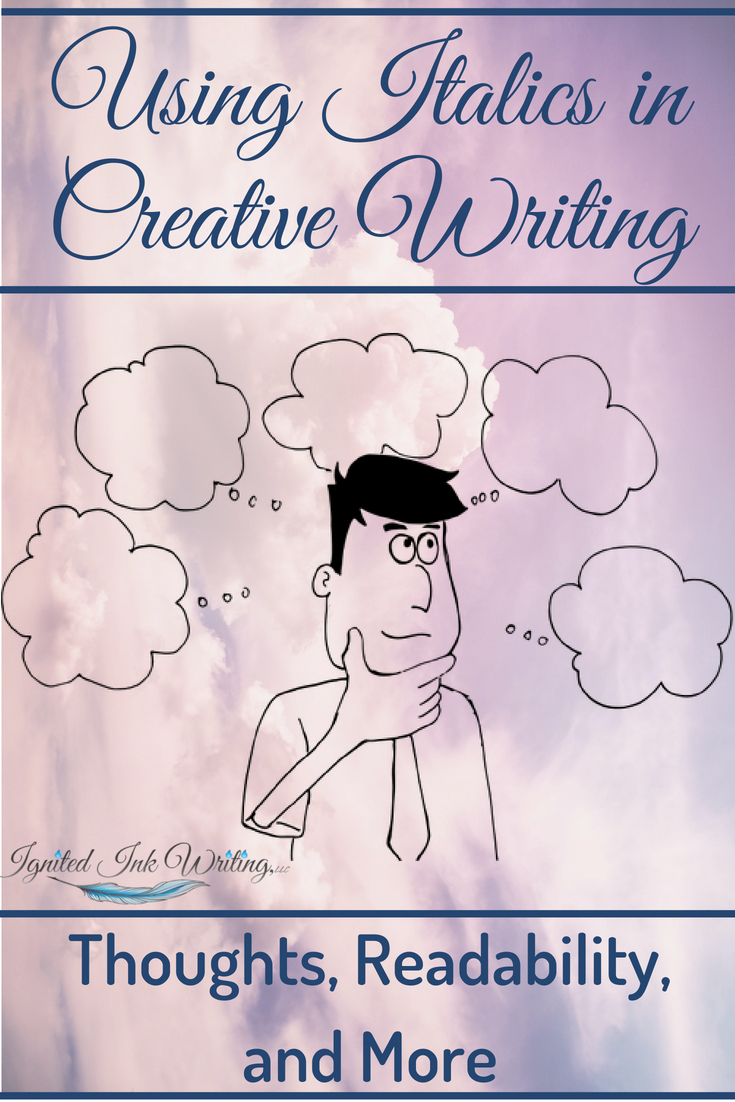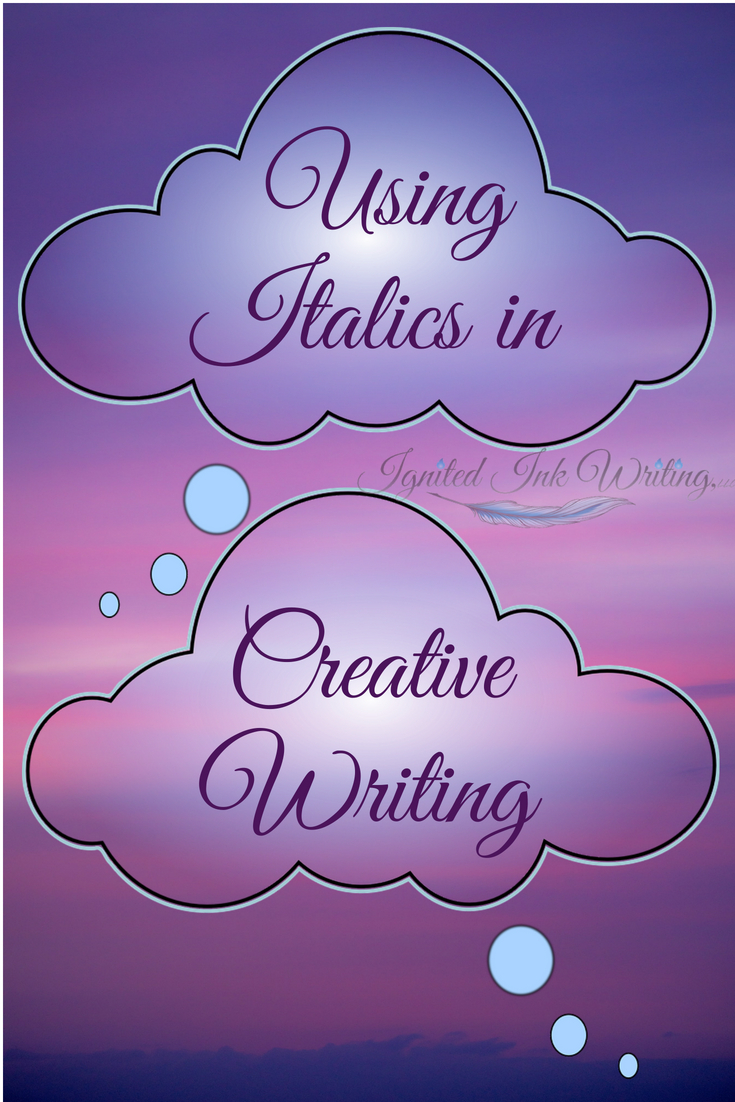What Does Italics Mean In Writing
How to Use Italics in Creative Writing: Thoughts, Readability, and More
Italics can be used to denote many different aspects of language, and in today's virtual word, they are used a lot. When used correctly, they clarify an author's meaning. However, like many kinds of stylized texts and punctuation, they can be overused and used incorrectly. Italics in creative writing are often used for thoughts, foreign words, emphasis, and titles.
Thoughts

When an author wishes to visually differentiate between thoughts and dialogue, thoughts are often put in italics, especially when the phrase passing through the character's head is not preceded or followed by the phrase "so-and-so thought." In second and third person, italics are usually necessary (without the "so-and-so thought"). First person stories, however, do not always need them. Because the whole story is being told from a specific character's point of view, readers infer that certain lines are thoughts of the character. Here are some examples of thoughts in and out of italics:
-
Kevin watched the two old men stand up and punch each other across the chess board. What is happening?
-
Kevin watched the two old men stand up and punch each other across the chess board. What is happening? he thought. or What is happening? he thought.
-
I looked back and forth between the mob waiting for the elevator and the stairs leading to the eighth floor. I don't know what to do! or I don't know what to do!
As a reader, writer, and editor, I prefer the certainty of italics, but I also acknowledge whether or not italics are used for thoughts is up to the author. I have seen symbols like brackets and colons used instead of italics when characters are communicating telepathically because these symbols are easier on a reader's eyes. Either way, signaling which phrases are thoughts and which are exposition adds an extra layer of clarity to the story.
Words in a Foreign Language
If an author wants to use a word or phrase from another language that does not appear in the Merriam-Webster dictionary, the word or phrase should be in italics. Authors often use other languages to add the flavor of a foreign country, show a character's heritage or multilingual abilities, or express something that doesn't translate well into English. Depending on the author's intended audience, they should make sure the gist of the foreign word or phrase can be understood through context or isn't vital information. Here are some examples of italics used to show a word or phrase is from a foreign language:

-
Kira stared at the menu in dismay. Words like le pain, le cuisse, and la volaille swam before her; she couldn't decipher the meaning of any of them.
-
"Dònde està el baño?" asked Diego. "Around the corner," said Sam, pointing to the restroom sign.
Putting the foreign words in italics tells readers that the words are actually foreign, not just terms they might be unfamiliar with. Also, whenever possible, writers should use the proper symbols to spell foreign words. In Spanish n and ñ are two different sounds, and the tilde can completely change the meaning of the word.
Emphasis and Style
The most difficult to pin down uses of italics are emphasis and style. Often, an author italicizes words they want to stress or make stand out. For example: "But, Mom, I don't want to!" If a reader can't tell which word is emphasized through the context and order of the sentence, italics can help clear this up. However, if the reader can tell which word is emphasized, italics can still be used, but they are not necessary. Don't use italics as an excuse for lazy writing in this instance. If you want a particular point to stand out, arrange the surrounding text to emphasize that point. You could give that sentence it's own paragraph or make that idea the culmination of the scene. I have worked with mulitple speakers how use italics to show where they should add extra inflection to their speech. That is a great trick but not an accepted use of italics in creative writing.
I often see writers use italics when they are experimenting with form or the way a piece looks on the page. While I encourage authors to push the boundaries of style, there are better ways to make certain sections stand out, such as changing fonts and indentations. Don't make your readers work too hard.
Titles
On occasion, authors want to mention a specific book, TV show, or song within a story, so they should know the proper format to do so. Titles that should be italicized when referenced include novels, books, magazines, newspapers, podcasts, TV shows, movies, blogs, and music albums. Titles that should be in quotation marks, not italics, when referenced are short stories, poems, essays, articles, individual episodes, individual posts, and songs. Here are some examples:
-
Podcast: The Way I Heard It
-
Episode of a podcast: "Oh Brother!"
-
-
Album: SkyWorld
-
Song: "All Is Hell That Ends Well"
-
-
Blog: Ignite Your Ink
-
Blog Post: "Using Italics in Creative Writing: Thoughts, Readability, and More"
-
Cautions for Italics from an Editor

One of the most important things to remember about italics is that they are difficult to read. When used sparingly, for a word or sentence, they are great, but they are exhausting to read for an entire paragraph or chapter. As an editor, if I receive a long passage in italics, I will change it to regular, non-italicized font to edit. Try it for yourself. Convert a page of single-spaced text to italics and read through it. Was that version more difficult to read? Did you have to expend more energy? With a plethora of books available today, I, as a reader, am not going to pick the story that is more difficult to read because of italics.
Also, backstory does not need to be in italics; transition to the flask back with a sentence like "The smell of wet dirt brought her back to her grandmother's vegetable garden in Kentucky."
In addition to readability, italics lose their effectiveness the more often they are used. If one word on the page is italicized, it really stands out. If every third word on the page is in italics, none of them stand out. Like exclamation points and colons, italics are most impactful when used in moderation. This also applies to words in foreign languages. If a text is filled with italics because a quarter of the words are foreign, there is a good chance only readers proficient in both the primary language and second language will be able to follow the story. This drastically reduces the piece's audience.
Italics are a great tool when used properly and not overdone. They can emphasize a word or phrase or denote a character's thoughts. They should always be used for titles of things like books and albums and words from a foreign language. A great tool, italics can help authors ignite their ink, so their story stands out and lingers with readers.
Get More Writing Tips!
If you found this article helpful, subscribe to Ignite Your Ink. You'll be notified when new articles are available and receive writing advice from a professional editor just for subscribers.
Thank you for subscribing to Ignite Your Ink
As a sign up bonus, you'll receive a free writing prompt designed to help improve your writing skills.
Do you have any questions or thoughts about italics? Share them in the comments below and for more advice on writing mechanics like this subscribe to Ignite Your Ink below.
Read Blog

Caitlin Berve is a fantasy author, editor, and speaker. Through Ignited Ink Writing, she edits novels, creates video tutorials, and writes. Using her MFA, she teaches creative writing at conferences, colleges, and Colorado writers' organizations. Her collection of modern fairy tales When Magic Calls is available in paperback, ebook, and audiobook formats. Caitlin seeks to fill the world with the kind of writing that lingers with readers and find magic in modern times.
Related Articles

The words of your story aren't the only pieces of writing you might have. You might also want to include letters, notes, emails, text messages, IMs, or some other form of written communication. Learn the various formatting options you have to make it clear when your story's written documents begin and end.
Read More →

Like in speech, a pause can be essential to conveying your message through writing. You have a variety of punctuation marks available to show those pauses, including em dashes, but not all pause punctuation marks are interchangeable. Learn what the different dashes and ellipses mean.
Read More →

One of the best techniques to increase the pacing and characterization of your story is dialogue. In order for your dialogue to be clear and effective, you have to know how to format and punctuate it. Discover the standard format for dialogue, when to use it, and when to choose a different option.
Read More →

When it comes to sentence organization, many writers nod off or only care enough to be clear, but the kind of syntax you use has a tremendous impact on voice. A child is going to arrange their sentences differently than a psychologist. Your sentences will look different than another author's. Syntax is a key aspect of your story's voice.
Read More →

There are situations when plain text needs to be manipulated in order clarify your intentions as an author. Italicizing the text is one of the most common and useful ways of modifying font in creative writing. Italics both stand out from and fit in with regular font.
Read More →

Colons are semicolons are powerful tools used to connect ideas at the sentence level, but they are seldom used in creative writing. Find out how something as simple as a punctuation mark can elevate your writing, so it leaves a greater impression on your readers. Colons and semicolons aren't just for emojis :)
Read More →
Master Writing Mechanics, Formatting Your Story, Your Writing Education
italics, writing mechanics, formating, punctuation, thoughts, emphasis, style, formatting
22 Comments
What Does Italics Mean In Writing
Source: https://www.ignitedinkwriting.com/ignite-your-ink-blog-for-writers/using-italics/2017
Posted by: keegansuching.blogspot.com

0 Response to "What Does Italics Mean In Writing"
Post a Comment